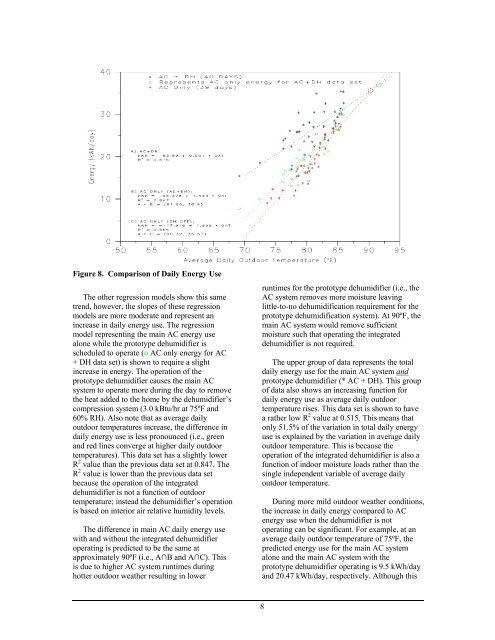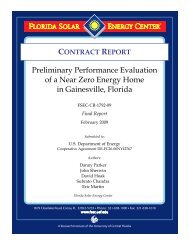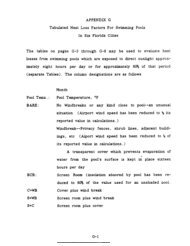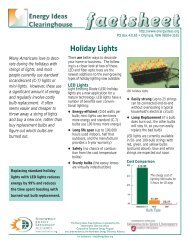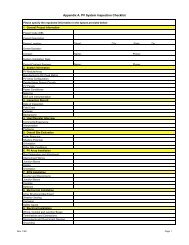Case Study of an Innovative HVAC System with Integral Dehumidifier
Case Study of an Innovative HVAC System with Integral Dehumidifier
Case Study of an Innovative HVAC System with Integral Dehumidifier
You also want an ePaper? Increase the reach of your titles
YUMPU automatically turns print PDFs into web optimized ePapers that Google loves.
Figure 8. Comparison <strong>of</strong> Daily Energy Use<br />
The other regression models show this same<br />
trend, however, the slopes <strong>of</strong> these regression<br />
models are more moderate <strong>an</strong>d represent <strong>an</strong><br />
increase in daily energy use. The regression<br />
model representing the main AC energy use<br />
alone while the prototype dehumidifier is<br />
scheduled to operate (o AC only energy for AC<br />
+ DH data set) is shown to require a slight<br />
increase in energy. The operation <strong>of</strong> the<br />
prototype dehumidifier causes the main AC<br />
system to operate more during the day to remove<br />
the heat added to the home by the dehumidifier’s<br />
compression system (3.0 kBtu/hr at 75ºF <strong>an</strong>d<br />
60% RH). Also note that as average daily<br />
outdoor temperatures increase, the difference in<br />
daily energy use is less pronounced (i.e., green<br />
<strong>an</strong>d red lines converge at higher daily outdoor<br />
temperatures). This data set has a slightly lower<br />
R 2 value th<strong>an</strong> the previous data set at 0.847. The<br />
R 2 value is lower th<strong>an</strong> the previous data set<br />
because the operation <strong>of</strong> the integrated<br />
dehumidifier is not a function <strong>of</strong> outdoor<br />
temperature; instead the dehumidifier’s operation<br />
is based on interior air relative humidity levels.<br />
The difference in main AC daily energy use<br />
<strong>with</strong> <strong>an</strong>d <strong>with</strong>out the integrated dehumidifier<br />
operating is predicted to be the same at<br />
approximately 90ºF (i.e., A∩B <strong>an</strong>d A∩C). This<br />
is due to higher AC system runtimes during<br />
hotter outdoor weather resulting in lower<br />
runtimes for the prototype dehumidifier (i.e., the<br />
AC system removes more moisture leaving<br />
little-to-no dehumidification requirement for the<br />
prototype dehumidification system). At 90ºF, the<br />
main AC system would remove sufficient<br />
moisture such that operating the integrated<br />
dehumidifier is not required.<br />
The upper group <strong>of</strong> data represents the total<br />
daily energy use for the main AC system <strong>an</strong>d<br />
prototype dehumidifier (* AC + DH). This group<br />
<strong>of</strong> data also shows <strong>an</strong> increasing function for<br />
daily energy use as average daily outdoor<br />
temperature rises. This data set is shown to have<br />
a rather low R 2 value at 0.515. This me<strong>an</strong>s that<br />
only 51.5% <strong>of</strong> the variation in total daily energy<br />
use is explained by the variation in average daily<br />
outdoor temperature. This is because the<br />
operation <strong>of</strong> the integrated dehumidifier is also a<br />
function <strong>of</strong> indoor moisture loads rather th<strong>an</strong> the<br />
single independent variable <strong>of</strong> average daily<br />
outdoor temperature.<br />
During more mild outdoor weather conditions,<br />
the increase in daily energy compared to AC<br />
energy use when the dehumidifier is not<br />
operating c<strong>an</strong> be signific<strong>an</strong>t. For example, at <strong>an</strong><br />
average daily outdoor temperature <strong>of</strong> 75ºF, the<br />
predicted energy use for the main AC system<br />
alone <strong>an</strong>d the main AC system <strong>with</strong> the<br />
prototype dehumidifier operating is 9.5 kWh/day<br />
<strong>an</strong>d 20.47 kWh/day, respectively. Although this<br />
8


